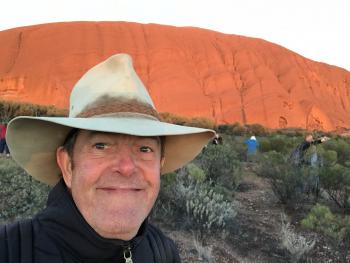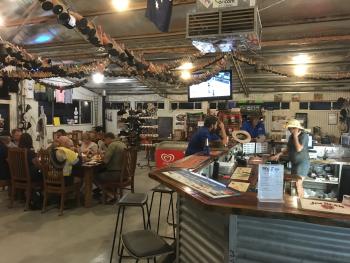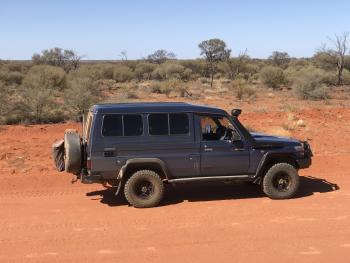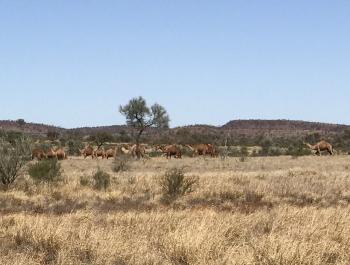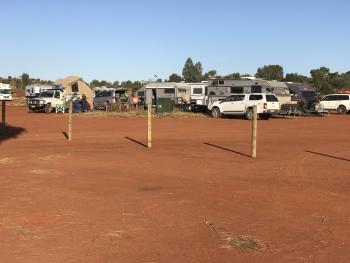Bentley’s 4WD cross-Australia adventure (Part two)
This item appears on page 50 of the September 2018 issue.
An Aussie friend, David Bentley, recently completed a coast-to-coast journey solo from northeastern Australia to the far southwest in his faithful Troopy (78 Series Toyota Land Cruiser). This 3-part article is edited from his daily reports. — Randy Keck
Day 4 (May 10, 2018) — I'm now at the famous Aussie Red Centre and Northern Territory landmark of Ayers Rock, officially known as Uluru. I had a nice, easy drive on well-graded gravel road all the way from Mt. Dare to Kulgera, a roadhouse pit stop on the main highway from Adelaide north to Alice Springs that promos itself as having the first and last pub in the Northern Territory. The weather was perfect, and there was virtually no other traffic.
I stopped at Finke, once a stop on the old Ghan line until the late 1970s, when the railway lines were relocated due to perpetual flooding. Today, it's a small dorp of a place with a population of about 250 Aboriginals, who remained behind when everyone else relocated. The place was unsightly, to say the least, but the locals were friendly enough and seemed content with life.
Fuel is expensive in the Outback, ranging from [AUD] $1.95 to $2.40 per litre [about US$5.60-$7 per gallon]. My fuel consumption was 77% higher than normal when crossing the sand dunes because I was in second gear most of the time and giving the engine plenty of revs.
Reflecting now on the Simpson crossing, the desert was fabulous. I love deserts, with their quiet stillness, timelessness, peace and serenity plus the amazing feeling of vastness when you gaze up into the sky at night. Also enjoy the solitude. Being totally alone has never bothered me.
On the one hand, it would be more pleasurable if I were sharing it with my wife, Jane, but in truth I don't think she would enjoy it much. It's a very "blokey" thing to do, as an old mate of mine named Rodger once said.
At Ayers Rock, I went to a bush tucker talk and learned a lot about the abundance of natural food available in the desert, if you know what to look for and how to find it.
You have to acknowledge the First Australians. They were and remain masters at finding food in the bush. We latecomers, by comparison, are basically clueless. If famed explorers Burke and Wills, in 1861, had been astute enough to befriend the Aboriginals they encountered, I'm sure they'd have survived instead of perishing. I learned how to find bush tomatoes, bush figs and all sorts of delectable tucker. Forget the supermarket! The aborigines never learned how to brew bush beer, though, which is a pity.
I'm booked on an early-morning walk around the Rock at 6 a.m. tomorrow. Jane did it years ago and highly recommended it to me. It'll be cold, though! I asked if I could also climb the Rock, but my request was politely declined. Anyway, I've climbed it three times before, the first time in 1973 (and barefoot too).
Day 5 (May 11) — Ayers Rock was interesting and always fascinates me. I did the morning guided walk around the base this time with a guide who was knowledgeable but not an Aboriginal as I had hoped. He had good knowledge of the Rock's spiritual meaning to the Aboriginals, though, and about the plants and trees around it.
Apparently, the Aboriginals can't see any point in climbing the Rock because you won't find any kangaroos or emus up there, which makes good sense if you're a hunter/gatherer, I suppose.
Permits are required for just about everything at the Rock. This includes a permit to enter the national park, a permit to camp in the campground and even a permit to drink. For the first time in Australia, I was refused a beer in the pub; I didn't have my campground permit with me. I was not happy about that but simply went back to the Troopy, which was in the pub car park, and got one of my own Coronas from the fridge, then happily sat and drank it on a bench at the pub entrance. All was well.
The Australian federal government handed back the freehold title to Ayers Rock and all the surrounding bushland to the local indigenous population in 1985. The condition was that the government had a 99-year lease on the area occupied by the Rock and the resort. A clause in the lease stated that tourists could still climb the Rock but only if more than 25% who entered the park actually did climb it.
Since the indigenous landlords really don't want visitors climbing the Rock, they do everything possible to discourage the practice. After 26 October 2019, they will legally be able to officially stop all climbing of Ayers Rock, so I'm glad I climbed it when I did.
Day 6-7 (May 12-13) — I've moved on to Laverton, having crossed into Western Australia, near Kalgoorlie. I left Ayers Rock at 2 p.m. Friday and camped in the bush near the WA border, at Docker River. It was cold as charity during the night, as expected.
The road from Ayers Rock was gravel all the way but excellent dirt. I set the cruise control at about 90 kph and just relaxed. They're trying to promote it as the "Outback Way," a section of the route from the Far North Queensland tourism center of Cairns, on the east coast, to Kalgoorlie, and they grade it regularly. I didn't pass many cars, though, only about 10 all day.
Laverton (pop. 340) is yet another tiny Outback town, with little appeal. A little excitement as I hit a roo near the town, but luckily no damage to the Troopy. Not sure how the roo fared. Anyone driving without a roo bar in the Outback is crazy, but some do.
Day 8-9 (May 14-15) — I was in Kalgoorlie Monday, 14 May, and did a service on the Troopy. I've driven about 4,000 kms since leaving home in Mooloolaba, so it was about due. No problems mechanically. All seems fine with the Troopy, thankfully, even after the hammering it had over the Simpson Desert.
I stayed the night in an old pub in the main street of Kalgoorlie, the Exchange Hotel, which was a delightful old, two-storey colonial place, built in 1900. The historic structure sported high ceilings, prized jarrah-wood staircases, creaky floorboards and, just to keep things authentic and original, no en suite bathrooms.
Kalgoorlie (pop. 33,000) was established in 1893 during a major gold rush. Of particular interest to visitors is a gold-mining museum and the gigantic Super Pit, which was Australia's largest open-cut gold mine until 2016.
Situated 595 kms east of Perth, Kalgoorlie is at the end of the Great Eastern Highway.
Next month, David Bentley completes his account of driving across Australia.
You may reach Randy at 80 America Way, Jamestown, RI 02835; 401/560-0350, randykeck@yahoo.com.

